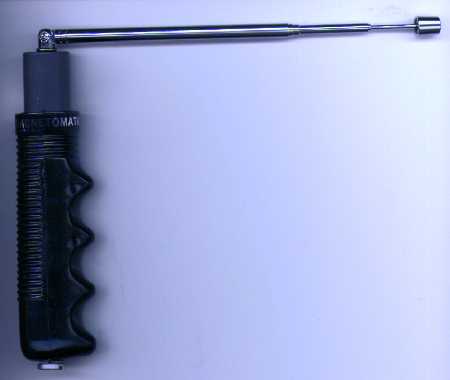 

MAGNETOMATIC PIPE AND CABLE LOCATOR
MAGNETOMATIC WILL LOCATE:-
- PVC Plastic Pipe (With or Without magnets or tracers)
- Iron or Steel Pipe
- Electrical Cables
- Ceramic Pipe
- Telephone Cables
- Asbestos Cement Pipe
- Conduits
- Concrete Pipe
- Fiber Optics
ALL OF THIS VERSATILITY IN ONE INSTRUMENT
FEATURES:-
- NO DIALS
- NO BATTERIES
- NO INTRICATE MECHANISMS TO GET OUT OF ORDER
- ONLY ONE MOVING ASSEMBLY
- COLLAPSES INTO A NEAT PACKAGE THAT WILL FIT IN YOUR HIP POCKET, OR MAY BE CARRIED ON YOUR BELT IN THE CASE
This principle has been successfully used for centuries employing a variety of materials with varying degrees of effectiveness.
Magnetomatic is a highly sensitive instrument designed, engineered and field tested to ensure reliabilty and accuracy. The Magnetomatic is sold worldwide. It is used successfully by Municipal and Sewer Departments, Telephone Companies, Plumbers, Excavators and many others.
Skill is required to operate this instrument but it is relatively easy to master, if instructions and practices recommended are followed. Easy to follow instructions are included with each Pipe Locator.
EASY-TO-FOLLOW INSTRUCTIONS
READ CAREFULLY BEFORE USING
In essence, MAGNETOMATIC a highly sensitive Instrument, Is designed to locate the following pipes and
cables underground or underwater.
IRON PIPE
PLASTIC PIPE (PVC)..
CONDUITS
---The Plastic Pipes with or without Magnets or Tracers.
CERAMIC PIPE
TRANSITE PIPE
ELECTRICAL CABLES
CONCRETE PIPE
TELEPHONE CABLES
FIBER OPTIC CABLES
The Magnetomatic Is engineered and field tested to Insure reliability and accuracy. The Magnetomatic has been sold to and is being used by municipal water and sewer departments, contractors, excavators, telephone companies, plumbers, Rent-All Shops,gift markets, rural water systems and others.
RECOMMENDATIONS FOR PRACTICE BEFORE USING THIS INSTRUMENT
The Magnetomatic Pipe Locator is delicately balanced and twenty to thirty minutes should be spent in getting the "feel" of operating this Instrument. Do not attempt to operate or test before reading the instructions. Testing above ground is recommended before using on the work site. For maximum sensitivity the indicator MUST be balanced. The operator's hand must continuously make minor adjustments to maintain proper balance as he walks across an area (this Is easily accomplished with practice). When properly balanced. the indicator will "float" and respond quickly to the attraction of the pipe.

It is suggested that a three foot or longer length of pipe (PVC or Metal) be placed on top of the ground where there is no buried pipe to interfere with the practice. Approach the pipe from different directions and angles, observing carefully the indicator's action in each set of circumstances. The Operator frequently has a natural tendency to walk too fast when using the Magnetomatic Pipe Locator. When the indicator begins to move, the operator should proceed very slowly, allowing the pipe time to attract the indicator. Following the "above ground" practice. a known location of buried pipe or cable Should be chosen and several practice runs made under actual operating conditions. The location, when found, can be marked by a stake, keel mark on concrete or asphalt, or by a squeeze bottle of common carpenter's chalk. This Instrument may be used in the interior of structures, as well as outside to locate pipe, conduit and cable. There are some individuals who cannot use the Magnetomatic Pipe Locator. If an operator during the test of the unit cannot get any movement from the indicator after repeated attempts, a new operator should be chosen.
OPERATING INSTRUCTIONS
STEP 1- extend the indicator to it's full length (24"). Figure 1.
Figure 1
Figure 2

<
Figure 4

:.m
STEP 2-Carefully
fold the Indicator over to an exact right angle (90�) with the handle
(Figure 2). This removes friction on the shaft and allows the indicator to rotate freely on
the rim.
WARNING:
Do not tamper with the retaining screw at bottom of Location. This is not an
adjustment screw. Tampering will void warranty.
10 GROUND
For the purpose of Illustration. the object being sought will be referred to as "pipe".
STEP 3-Grip
the handle firmly and hold the instrument at a comfortable arm's length
with the indicator parallel to the ground.surface and pointing straight in front of the
operator. (Figure 3)
STEP 4-The
operator should walk slowly across the suspect area. As the operator
passes over the buried pipe, the indicator will begin to swing in the direction the pipe is
running. (Figure 4) PROCEED VERY SLOWLY AT THIS POINT.
As the handle Is moved directly over the pipe, the indicator will lay parallel to the pipe.
(Figure 4). If the operator continues beyond the pipe, the tip will point back. By moving
forward or backward very slowly the operator can accurately determine when the
indicator is laying exactly parallel above the pipe.
To trace a pipe to it s terminus. point the indicator in the direction the pipe is running
and walk slowly. The tip will remain over the pipe. When the handle passes beyond the
end of the pipe, the indicator will make a 1800 turn and point backward toward the
terminus. If the pipe proceeds In another direction through a "T" or elbow. you can
check to each side of the terminus point and locate the new direction of travel.
NOTE: Proper balance in the operator's hand is important. If the indicator Is tilted to one side, gravity will overcome the sensitivity of
the Indicator. Shoes with thick soles that insulate the operator from the ground may cause the pipe locator to operate improperly.
Nylon clothing such as a jacket or raincoat is believed to cause static electricity which could affect the sensitivity of the indicator. If
this is suspected remove the nylon garment(s).
CAUTION: Do not leave the Instrument in direct sunlight for an extended period of time, i.e., on dashboard or in a metal tool box in
the back of an open truck.'
|